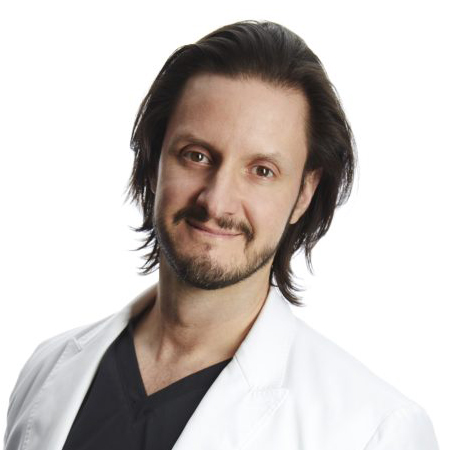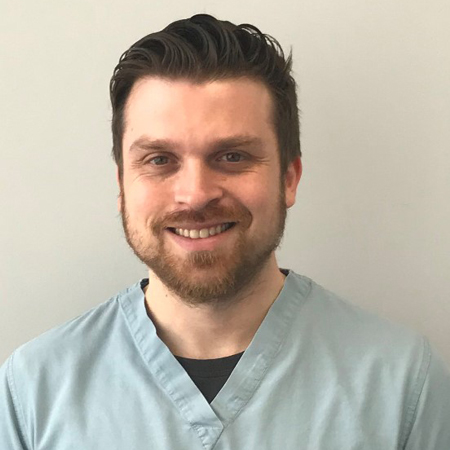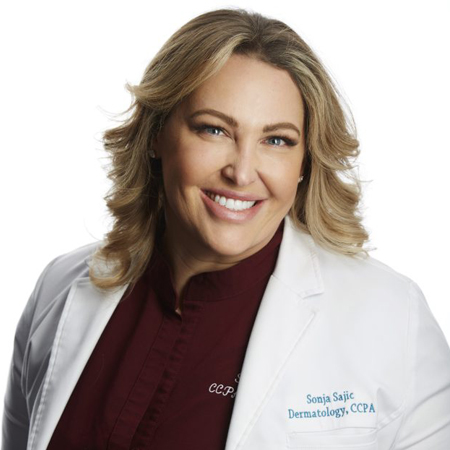Facial aging occurs in multiple ways that involve much more than just the skin’s appearance. Changes to fat, muscles, and bones underneath the skin also influence your overall appearance, and these changes are unique to each individual. Our signature approach to anti-aging treatment in Guelph, ON, is the 5-Dimension Skin Plan™, an innovative, science-based approach developed by Royal College-certified dermatologist Dr. Dusan Sajic using the latest research, medicine, and technology.
The 5 Dimension Skin Plan is offered exclusively at deRMA Skin Institute and sets our practice apart from other skincare specialists. By addressing the integrated causes of aging—whether you’re in your 20s or 70s or anywhere in between—we can delay or reverse signs of aging so that you look like the healthiest, most vibrant version of yourself.
Learn more about how we can prevent and reverse aging in your age group.
See For Yourself





Keep in mind that each patient is unique and your results may vary.
Derma Skin Institute is a medical and cosmetic dermatology practice in Guelph and Burlington that serves the Southern and Southwestern Ontario areas. Dr. Dusan Sajic, Dr. Richard Backstein, Dr. Daniel Wong, and Dr. Tiffany Chen are certified by the Royal College of Physicians and Surgeons of Canada. Dr. Sajic performs a range of anti-aging skincare treatments which include, but are not limited to laser skin tightening, CO2 skin resurfacing, AccuTite, Dysport, Botox, Radiesse, Sculptra, and platelet-rich plasma (PRP) treatment. Derma Skin Institute also offers radiofrequency microneedling and lasers to target concerns such as acne scarring, rosacea, sun damage, among other procedures. Women and men seeking dermatology treatments from the GTA to London and surrounding area choose deRMA Skin Institute.
What Causes An Aged Appearance?
Why do wrinkles develop? What causes age spots to appear? Why does skin sag as we get older? How can we retain a youthful face shape? Instead of simply addressing the symptoms of aging, such as wrinkled skin, Dr. Sajic and the other specialists at our practice use the 5 Dimension Skin Plan to create comprehensive treatment plans starting with the foundation.
Understanding the 5 dimensions of facial aging and the condition of each patient enables us to tailor our treatments for a patient’s specific needs.
The 5 Dimensions Of Aging Include:
Bone Loss
Few people consider bones an important part of facial aging. But after about age 35, the regeneration of bone cells decreases, which can lead to under-eye hollows, flattened cheeks, an undefined jawline, and a receding chin. Additionally, the loss of structure beneath the skin can cause sagging, lines, and folds.
Fat Loss Or Displacement
Fat diminishes and shifts downward as we age, so features that had youthful plumpness with smooth skin begin sagging. The result can be jowls, a double chin, and bags under the eyes called festoons and malar mounds.
Structural Skin Loss
This is the dimension that’s most commonly addressed by aesthetic treatments such as laser skin rejuvenation, microneedling, and other procedures that stimulate the production of new collagen. As we age, the skin produces less elastin, collagen, and hyaluronic acid—all of which are the essential building blocks of tight, smooth skin.
Textural And Pigment Changes To The Skin’s Surface
Age-related changes to the skin’s texture are caused primarily by sun exposure, resulting in brown spots and other discolouration. Other textural changes noticed with age include scarring, roughness, and wrinkles.
Muscle And Movement Imbalances
Expression lines, also called dynamic wrinkles, develop after years of squinting, smiling, frowning, and all the other ways we change expressions. These all involve the movement of tiny facial muscles that result in crow’s feet, the “11s,” forehead wrinkles, and marionette lines around the mouth.
Key Skin Functions And The Skincare Products Ingredients To Address Them
Anti-Aging
Most people think of retinol for anti-aging as it has the most data for improving collagen and wrinkles. It also performs many functions in the skin – from increasing collagen, to stabilizing cell turnover, to reducing inflammation and scars, to name a few. However, the type of retinol chemistry and science in your anti-aging skincare product matters. In general, over-the-counter retinols tend to be 20 to 50 times less potent than retinoic acid skincare products.
All patients need the potency to fight signs of aging. Think of retinol in terms of lifting weights: you start slowly and work your way up. Retinol can have side effects, including sensitivity to sun and significant peeling of the skin. Dr. Sajic recommends consistent use of moisturizer to combat the drying effects of retinol on the skin.
For those not able to tolerate retinol an excellent alternative for anti-aging skincare is amino peptides, which have most of the collagen building properties of retinol with the added benefit of increasing skin elasticity and building elastin. Amino peptides are also much better at giving skin a radiant glow when compared to retinol.
Bakuchiol is another ingredient that has recently shown promise for those with sensitive skin who do not tolerate the side effects of retinol well.
Recommended anti-aging creams with retinol, retinoic acid, and peptides:
- Sajic Skin Science Renutriate Sensitive
- Skinceuticals Retinol .5
- ZO Skin Health Retinol Skin Brightener 1%
- SkinBetter Science AlphaRet Overnight Cream
DNA Repair
From sun and UV exposure to chronic inflammation, exposure to pollutants and other toxins, the skin is bombarded with many factors that cause DNA damage over time. A big part of skin aging is due to DNA damage, which can also lead to skin cancer! This is where retinol needs extra help to fight signs of aging in the skin.
Properly formulated green tea extract has been shown to lead to the production of DNA repair enzymes in the skin. This gives your skin the ability to repair itself. Green tea extract also has anti-inflammatory, antioxidant, and antimicrobial properties, among others.
Other enzymes shown to have DNA-repairing properties are oleuropein and hydroxytyrosol (Hidrox), found in olive leaves and extra virgin olive oil,
Be sure to look for anti-aging skincare creams that have DNA repair enzymes, or DNA repairosomes, built right in.
Recommended anti-aging creams with DNA repair ingredients:
Anti-Oxidants
Reactive oxygen molecules, also known as free radicals, attack our skin and collagen, and this can lead to early degradation and pigmentation changes. Vitamin C (ascorbic acid) is a poster child for counteracting the damage caused by free radicals, and many know about it. However, Vitamin C’s anti-oxidant properties are also some of the most difficult to keep stable and the easiest to not formulate properly, so it is important to select your anti-oxidant skincare wisely.
There is an even more powerful antioxidant that is 100x more powerful than Vitamin C: hydroxytyrosol, or Hidrox. It is an anti-aging skincare product derived from olives. (Remember that using regular olive oil will damage your skin, so stick to skincare products containing Hidrox.) In addition to its antioxidant properties, hydroxytyrosol has been also shown to help with DNA damage, to repair the skin barrier, and to have antibacterial and anti-inflammatory effects, just to name a few.
Vitamin C does have skin brightening properties, so it can be helpful to add it or similar ingredients to your anti-aging skincare regimen for this reason.
Recommended anti-aging creams with anti-oxidant ingredients:
- Sajic Skin Science Renutriate Sensitive
- Rejuvenant
- Skinceuticals CE Ferulic® with 15% L-Ascorbic Acid
- Vivier GrenzCine Serum
- SkinMedica TNS Essential Serum
- SkinBetter Science Alto Defense Serum
Microbiome Repair (Pre- /Probiotics)
A lot of disease stems from the wrong type of bacteria growing on the skin. Our skin actually has more bacteria on it when healthy than our own skin cells. When the wrong type of bacteria takes over, disease and aging are accelerated. For this reason, it’s important to re-establish a healthy proportion of beneficial bacteria that are critical for optimal skin health.
Again, green tea rules here as the anti-aging product with the most data to support repairing the microbiome. But again, proper concentrations are critical because too much green tea can cause irritation which will favor some pathogenic bacteria.
Applying probiotic strains on the skin has not been tested and is an active area of research, so for that reason I would not recommend it at this time.
Recommended anti-aging creams with microbiome-repairing ingredients:
Skin Barrier Repair And Radiance
When it comes to glowing skin, niacinamide research has shown the best results. It temporarily decreases pore size and helps with the repair function of the epithelial skin cells. Ingredients like cica, aloe and again hydroxytyrosol also help repair skin and fight signs of aging. Look for these ingredients in your anti-aging skincare products.
Recommended anti-aging creams with niacinamide ingredients:
- Sajic Skin Science Renutriate Sensitive
- La Roche Posay Cicaplasti Baune B5
- Avène XeraCalm A.D. Soothing Concentrate
Anti-Inflammation
Chronic inflammation and irritation also lead to accelerated degradation of our skin and can lead to less-than-optimal skin – from blemishes to faster degradation of collagen. Often this will require a prescription medication, but some topical ingredients that can help. These include oleuropein, green tea extract, allantoin, aloe, and cica, which have been shown down to slow down inflammatory molecules like matrix metalloproteinases (enzymes that degrade collagen and elastin).
Recommended anti-aging creams with anti-inflammatory ingredients:
Pigmentation Issues
When the skin becomes damaged, it can start producing uneven pigmentation. Independent studies have shown that uneven pigmentation ages us even more than wrinkles. While hydroquinone has traditionally been the go-to molecule to treat skin discoloration, it has recently fallen out of favour due to toxicity. We currently recommend only short exposures to hydroquinone.
For longer exposure, molecules like cystamine, arbutin tranexamic acid, kojic acid, glycolic acid, niacinamide, and Vitamin C have great data. Treating pigmentation often requires combining several of these ingredients. Again, some of them may cancel each other out, so it’s important to get a product that has been tested and validated by independent labs to ensure its effectiveness.
Recommended anti-aging creams with pigmentation-treating ingredients:
- SkinCeuticals Discoloration Defense
- Vivier Radiance Serum
Bonus: Reversal Of Senescence (Zombie Cells)
Cellular senescence is a stage at which the cells have put up the white flag and have stopped responding. These cells will then start spreading this message to other cells around them, leading them to also function sub-optimally. Currently only ablative lasers have been conclusively shown to reverse this. However, recent exciting data has been shown for Oleuropein, another Olive oil extract, though it remains to be confirmed by further independent studies.
Recommended anti-aging creams with microbiome-repairing ingredients:
Key Takeaway
Typically, anti-aging creams will only have one or two of the ingredients listed above. Even then, they are not always tested for the specific age fighting function they proclaim on the label. Getting all of the ingredients below to function in an all-in-one cream is very difficult, thus many patients have to resort to using more than one product.
Recently, after 5 years of intense research with top chemists and formulators, Sajic Skin Science has managed to put them all into one inclusive delivery complex: Sajic Skin Science Renutriate Sensitive. It gives our patients another option for anti-aging skincare with fewer steps.
Lastly, not all the ingredients like to play well together, so it is difficult to put them all in one cream. It is important to give your skin the nutrition it needs to return to its optimal health. This may mean multiple products that cover the 7 critical areas of skin health or an all-in-one solution like an anti-aging serum. Just make sure to check the results of the research studies.
Anti-Aging Skincare That Actually Works
It’s important to remember that there’s generally no one-size-fits-all anti-aging skincare treatment. However, there are some generalities that can be extrapolated and applied. Just like food, one should have a vegetable, a grain, a protein and a fruit. There are some that are more packed with nutrients and vitamins and antioxidants, but they may not be to one’s taste. It’s somewhat the same for skin care products to fight signs of aging for men and women.
The most important thing is to purchase your anti-aging skincare products from a company that has done independent research that shows these ingredients work well to fight signs of aging. There are studies that show that 90% of over-the-counter products don’t deliver what they promise to deliver.
The dosing, concentration, the pH, the level of skin penetration, and whether or not they interact with other ingredients are very key parameters that are often overlooked in many over-the-counter skincare products.
Dr. Sajic feels it is important to take a step back and look at the key health functions and challenges of the individual’s skin, then to assess which molecule is the best at addressing each of the issues.
He calls it the “optimal nutrition for the skin.” When we give the skin the tools and nutrients it needs, it will more likely return to its optimal condition.
5 Dimension Skin Plan Treatments By Age
As we age, multiple changes occur—both visible and invisible—that we at deRMA Skin Institute address with customized treatment plans. Unlike many other practices that focus only on a single concern, Dr. Sajic and our team of specialists design treatments only after assessing all 5 dimensions of facial aging and skin health.
That doesn’t mean every patient needs a specific treatment for each dimension—patients in their 20s may only require a bit of “preventative BOTOX®,” for example. It’s important, however, that we assess each patient’s needs from a comprehensive viewpoint.
With that in mind, here’s a look at typical treatments we recommend for patients at varying stages of life:
Ages 25-35
You may have heard the phrase “prejuvenation” as you researched anti-aging skincare treatments for people in their 20s or 30s online. This is the age group where preventative measures can truly postpone the onset of wrinkles and other signs of aging. In addition to using a broad-spectrum sunscreen, retinol, and vitamin C as part of your skincare regimen, micro-injections of BOTOX (sometimes called “Baby BOTOX”) can help prevent the development of crow’s feet, worry lines, and other “dynamic” wrinkles caused by muscle movements.
Skin at this age still retains ample amounts of collagen and elastin to prevent sagging, and bone loss and fat loss aren’t really a concern, either. “Starter” laser treatments, such as ClearLift™, are gentle, no-downtime procedures that work well with BELA MD facials to keep your skin glowing and refreshed.
Ages 35-45
At this age, all 5 dimensions of facial aging typically need to be addressed to maintain a youthful appearance. Various dermal fillers, including Sculptra® and Radiesse®, effectively offset bone loss and fat loss, while microneedling combined with radiofrequency energy stimulates the production of new collagen and elastin to restore firmness to your skin. We recommend targeting more pronounced frown lines and other expression lines with BOTOX, Dysport®, or XEOMIN® to relax the muscles responsible for these wrinkles.
Dr. Sajic is a leader in the research of leading-edge aesthetic lasers, and this is the age where we start to see more significant changes to the skin’s texture that can be addressed with a combination of less aggressive lasers such as DyeVL and ClearLift. Light to medium chemical peels are another skin resurfacing option at this age.
Ages 45-55
Combining more aggressive laser skin resurfacing with cosmetic injectables such as fillers and BOTOX addresses textural changes caused by the steep drop in collagen and elastin production and the increasing loss of bone and fat. We may recommend ablative fractional laser resurfacing at this point, such as CO2 or Pixel® Erbium lasers, which involve some downtime. Patients concerned about jowls, nasolabial folds, and lax neck skin can benefit from AccuTite, a non-invasive alternative to facelift surgery, combined with RF microneedling, and diluted Radiesse®.
Ages 55 And Above
Many of the same treatment combinations used for patients between ages 45 and 55 are appropriate even as you get older. The difference now is that facial plastic surgery may be the best approach to accomplish your rejuvenation goals. If you do get a facelift, eyelid surgery, or some other surgical procedure, nonsurgical treatments can help maintain the results.
Schedule A Consultation
Consulting with Dr. Sajic or another board-certified dermatologist or plastic surgeon is an essential step of the 5 Dimension Skin Plan. Patients looking for a comprehensive approach to anti-aging treatments in Kitchener, Cambridge, and surrounding areas in Southwestern Ontario choose deRMA Skin Institute for their treatments. Request a consultation using the online form or call us at (888) 803-3762 to schedule an appointment.

Dusan Sajic, MD, PhD

Richard Backstein, MD

Sonja Sajic, CCPA
With more than 20 years of experience, deRMA Skin Institute strive to offer patients the most advanced treatments available to keep their skin healthy and looking its best. Board Certified Dermatologist, Dusan Sajic, MD, PhD, board-certified Plastic and Reconstructive Surgeon, Richard Backstein, MD, FRCSC, and Sonja Sajic, CCPA are committed to providing state-of-the-art medical, surgical and cosmetic treatments to all patients in Guelp, Burlington, Cambridge, Kitchener, Hamilton, Milton, and surrounding areas.




